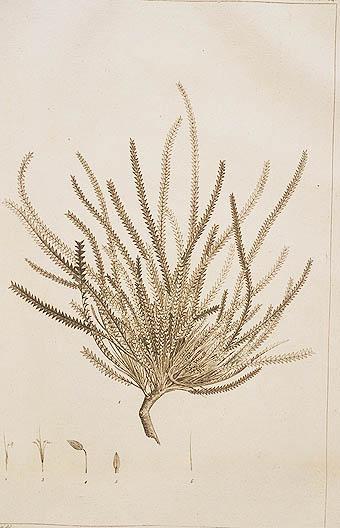Cygnis insignis (talk | contribs) Not certain about who and when, drop in comment out. |
It was Labill. who found it, but on the mainland during the search for Riche. |
||
| Line 16: | Line 16: | ||
'''''Banksia nivea''''', commonly known as '''Honeypot Dryandra''', is a [[shrub]] endemic to [[Western Australia]]. First described as ''Banksia nivea'', it was transferred to ''Dryandra'' as '''''Dryandra nivea''''' by [[Robert Brown (botanist)|Robert Brown]] in 1810, and remained in that genus until 2007, when all ''Dryandra'' species were transferred to ''[[Banksia]]'' by [[Austin Mast]] and [[Kevin Thiele]]. |
'''''Banksia nivea''''', commonly known as '''Honeypot Dryandra''', is a [[shrub]] endemic to [[Western Australia]]. First described as ''Banksia nivea'', it was transferred to ''Dryandra'' as '''''Dryandra nivea''''' by [[Robert Brown (botanist)|Robert Brown]] in 1810, and remained in that genus until 2007, when all ''Dryandra'' species were transferred to ''[[Banksia]]'' by [[Austin Mast]] and [[Kevin Thiele]]. |
||
This species was first collected by [[Jacques Labillardière]] in the vicinity of [[Esperance Bay]] between 15 and 17 December 1792, during a search for the naturalist [[Claude Riche]], who had become lost on the Australian mainland.<ref name="Duyker 2003">{{cite book | first = Edward | last = Duyker | year = 2003 | title = Citizen Labillardière: A naturalist's life in revolution and exploration | location = Carlton | publisher = Miegunyah Press | isbn = 0-522-85160-6}}</ref> It was described and figured in his 1800 account of the voyage, [[Relation du Voyage à la Recherche de la Pérouse]], under the name ''Banksia nivea''. In 1810 [[Robert Brown (botanist)|Robert Brown]] transferred it into a new genus, ''[[Dryandra]]'', and it remained there until 2007 when [[Austin Mast]] and [[Kevin Thiele]] transferred all ''Dryandra'' species into ''Banksia''.<ref name="APNI 54579">{{APNI | name = ''Banksia nivea'' Labill. | id = 54579}}</ref> |
|||
<!-- The species was described by [[Jacques Labillardière]] in [[Relation du Voyage à la Recherche de la Pérouse]], from his collection obtained at [[Observatory Island]] in 1792.<ref name="NLA">{{cite web|url=http://www.nla.gov.au/pub/nlanews/2002/sep02/article5.html|title=In search of La Pérouse|last=Duyker|first=Edward|date=September 2002 |work=NLA news Volume XII Number 12|publisher=National Library of Australia}}</ref> --> |
|||
[[Image:Banksia nivea by Chez Dabo.jpg|left|right|Foliage of ''B. nivea'' by Chez Dabo]] |
[[Image:Banksia nivea by Chez Dabo.jpg|left|right|Foliage of ''B. nivea'' by Chez Dabo]] |
||
{{-}} |
{{-}} |
||
Revision as of 11:40, 14 February 2009
| Honeypot Dryandra | |
|---|---|

| |
| B. nivea in flower at Lesmurdie Falls National Park | |
| Scientific classification | |
| Kingdom: | |
| (unranked): | |
| (unranked): | |
| Order: | |
| Family: | |
| Genus: | |
| Series: | |
| Species: | B. nivea
|
| Binomial name | |
| Banksia nivea | |
Banksia nivea, commonly known as Honeypot Dryandra, is a shrub endemic to Western Australia. First described as Banksia nivea, it was transferred to Dryandra as Dryandra nivea by Robert Brown in 1810, and remained in that genus until 2007, when all Dryandra species were transferred to Banksia by Austin Mast and Kevin Thiele.
This species was first collected by Jacques Labillardière in the vicinity of Esperance Bay between 15 and 17 December 1792, during a search for the naturalist Claude Riche, who had become lost on the Australian mainland.[1] It was described and figured in his 1800 account of the voyage, Relation du Voyage à la Recherche de la Pérouse, under the name Banksia nivea. In 1810 Robert Brown transferred it into a new genus, Dryandra, and it remained there until 2007 when Austin Mast and Kevin Thiele transferred all Dryandra species into Banksia.[2]

References
- ^ Duyker, Edward (2003). Citizen Labillardière: A naturalist's life in revolution and exploration. Carlton: Miegunyah Press. ISBN 0-522-85160-6.
- ^ "Banksia nivea Labill". Australian Plant Name Index (APNI), IBIS database. Centre for Plant Biodiversity Research, Australian Government.
- Cavanagh, Tony and Margaret Pieroni (2006). The Dryandras. Melbourne: Australian Plants Society (SGAP Victoria); Perth: Wildflower Society of Western Australia. ISBN 1-876473-54-1.
- Mast, Austin R. and Kevin Thiele (2007). "The transfer of Dryandra R.Br. to Banksia L.f. (Proteaceae)". Australian Systematic Botany. 20: 63–71. doi:10.1071/SB06016.
- "Dryandra nivea (Labill.) R.Br". FloraBase. Western Australian Government Department of Biodiversity, Conservation and Attractions.
External links
- "Dryandra nivea (Labill.) R.Br". Flora of Australia Online. Department of the Environment and Heritage, Australian Government.
- "Dryandra nivea (Labill.) R.Br". FloraBase. Western Australian Government Department of Biodiversity, Conservation and Attractions.
- "Banksia nivea Labill". Australian Plant Name Index (APNI), IBIS database. Centre for Plant Biodiversity Research, Australian Government.